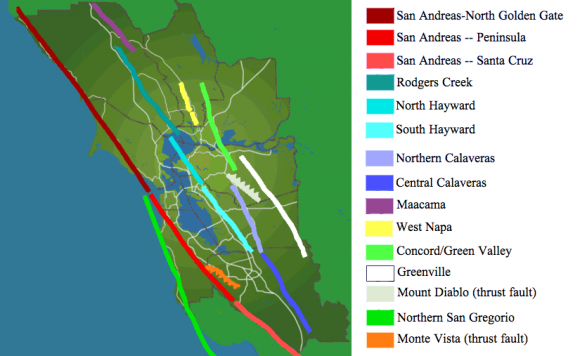
A new study published October 13, 2014 in
the Bulletin of the Seismological Society of America confirms
what many already know – that parts of California are due for a big earthquake.
In this case, it’s four urban areas of the San Andreas Fault system in Northern
California that have been shown to have stored enough energy to produce major
earthquakes. These four areas are: Hayward, Rodgers Creek, northern Calaveras
and Green Valley.
The earthquake cycle reflects the
accumulation of strain on a fault, its release as slip, and its re-accumulation
and re-release. The new study measured fault creep. Fault creep is the slip and slow
release of strain in the uppermost part of the Earth’s crust that occurs on
some faults between large earthquakes, when much greater stress is released in
only seconds. Where no fault creep occurs, a fault is considered locked, and
stress will build until it is released by an earthquake.
This study looked at how much creep occurs
on each section of the San Andreas Fault system in Northern California. Enough
creep on a fault can diminish the potential size of its next earthquake
rupture.
The San Andreas Fault system in Northern
California consists of five major branches that combine for a total length of
approximately 1250 miles. Sixty percent of the fault system releases energy
through fault creep, and about 28 percent remains locked at depth, according to
the authors.
Study author James Lienkaemper is a
research geophysicist at U.S. Geological Survey (USGS). He said: The extent
of creep on some fault sections is not yet well determined, making our first
priority to study the urban sections of the San Andreas, which is directly
beneath millions of Bay Area residents.
According to the study, four faults have
accumulated sufficient strain to produce a major earthquake. Three creeping
faults have large locked areas that have not ruptured in a major earthquake of
at least magnitude 6.7 since the reporting of earthquakes by local inhabitants:
Rodgers Creek, northern Calaveras and southern Green Valley. The southern
Hayward fault, which produced a magnitude 6.8 earthquake in 1868, is now
approaching its mean recurrence time based on paleo-seismic studies.
The authors also estimate three faults
appear to be nearing or have exceeded their mean recurrence time and have
accumulated sufficient strain to produce large earthquakes: the Hayward,
Rodgers Creek and Green Valley.
Bottom line: A study in the Bulletin of the Seismological Society of America suggests
that four urban areas of the San Andreas Fault system in Northern California
have stored enough energy to produce major earthquakes. These four areas are:
Hayward, Rodgers Creek, northern Calaveras and Green Valley.

No comments:
Post a Comment